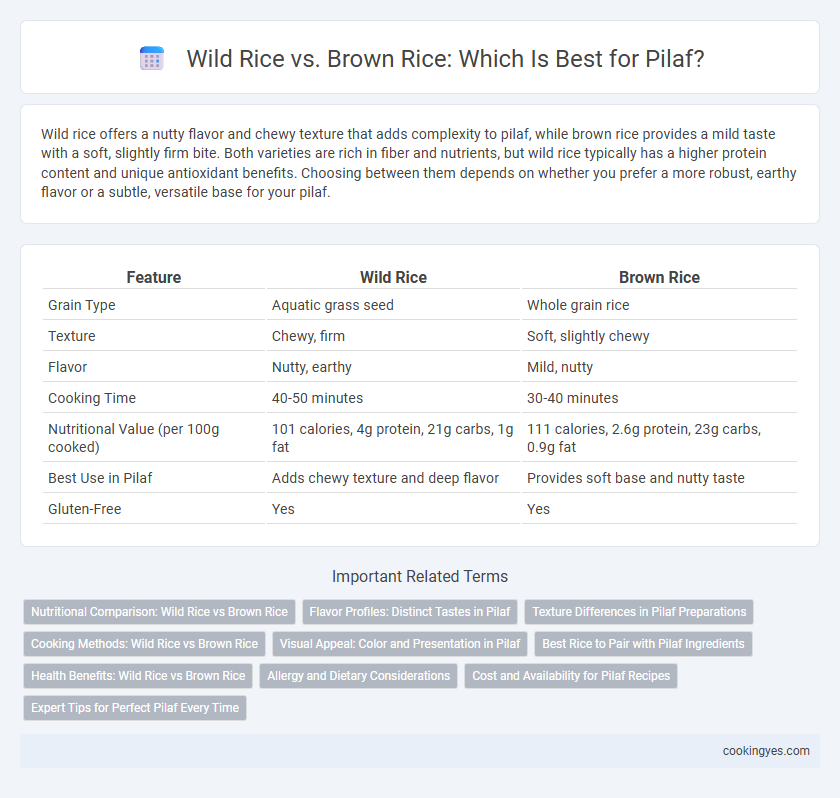Wild rice offers a nutty flavor and chewy texture that adds complexity to pilaf, while brown rice provides a mild taste with a soft, slightly firm bite. Both varieties are rich in fiber and nutrients, but wild rice typically has a higher protein content and unique antioxidant benefits. Choosing between them depends on whether you prefer a more robust, earthy flavor or a subtle, versatile base for your pilaf.
Table of Comparison
| Feature | Wild Rice | Brown Rice |
|---|---|---|
| Grain Type | Aquatic grass seed | Whole grain rice |
| Texture | Chewy, firm | Soft, slightly chewy |
| Flavor | Nutty, earthy | Mild, nutty |
| Cooking Time | 40-50 minutes | 30-40 minutes |
| Nutritional Value (per 100g cooked) | 101 calories, 4g protein, 21g carbs, 1g fat | 111 calories, 2.6g protein, 23g carbs, 0.9g fat |
| Best Use in Pilaf | Adds chewy texture and deep flavor | Provides soft base and nutty taste |
| Gluten-Free | Yes | Yes |
Nutritional Comparison: Wild Rice vs Brown Rice
Wild rice contains higher protein content and more fiber compared to brown rice, making it a nutritious choice for pilaf. Brown rice offers greater levels of manganese and magnesium, essential for metabolic health and bone strength. Both types provide antioxidants and complex carbohydrates, but wild rice's nutrient density supports better cardiovascular benefits.
Flavor Profiles: Distinct Tastes in Pilaf
Wild rice offers a nutty, earthy flavor with a chewy texture that adds depth and complexity to pilaf dishes, contrasting the mild, slightly sweet taste of brown rice. Brown rice, with its tender yet firm grains, provides a more subtle and familiar base that absorbs spices and herbs effectively. The distinct flavor profiles of wild and brown rice influence the overall aroma and taste, making wild rice ideal for robust, savory pilafs while brown rice suits lighter, more delicate preparations.
Texture Differences in Pilaf Preparations
Wild rice yields a firm, chewy texture in pilaf, providing a nutty flavor and substantial bite that holds well during cooking. Brown rice offers a softer, slightly creamy consistency with a mild, earthy taste, absorbing flavors more thoroughly but maintaining some grain integrity. Choosing wild rice enhances pilaf with a robust texture contrast, while brown rice creates a tender, cohesive dish.
Cooking Methods: Wild Rice vs Brown Rice
Wild rice requires a longer cooking time of about 45-60 minutes and benefits from soaking beforehand to soften its tough outer shell, while brown rice typically cooks in 30-40 minutes with a more consistent texture. For pilaf, wild rice's chewy, nutty grains hold up well during sauteing and simmering, creating a pilaf with a robust flavor profile. Brown rice absorbs flavors more readily and produces a tender pilaf, making it suitable for recipes that need a moist, cohesive texture.
Visual Appeal: Color and Presentation in Pilaf
Wild rice exhibits a dark, almost black hue that provides a striking contrast when used in pilaf, enhancing the overall visual appeal with its elongated grains. Brown rice offers a warm, golden-brown color that delivers a more subtle, earthy presentation, blending well with vegetables and herbs. The combination of wild rice and brown rice in pilaf creates a visually dynamic dish with varied textures and tones appealing to gourmet plating and food photography.
Best Rice to Pair with Pilaf Ingredients
Wild rice offers a nutty flavor and firm texture that complements hearty pilaf ingredients like mushrooms, nuts, and root vegetables, while brown rice provides a slightly chewy consistency and mild taste that blends well with herbs, spices, and lighter vegetables. Wild rice's robust profile pairs excellently with bold flavors and rich proteins such as chicken and sausage, whereas brown rice works best for pilafs featuring delicate herbs and subtle seasonings. Choosing between wild and brown rice depends on the desired texture and flavor balance to enhance the overall pilaf experience.
Health Benefits: Wild Rice vs Brown Rice
Wild rice contains higher protein and antioxidants compared to brown rice, making it a nutrient-dense choice for pilaf dishes. Brown rice offers more fiber and essential minerals like magnesium and selenium, supporting digestive health and immune function. Choosing wild rice or brown rice for pilaf depends on whether you prioritize antioxidant intake or higher fiber content for overall health benefits.
Allergy and Dietary Considerations
Wild rice and brown rice differ notably in allergy and dietary profiles, with wild rice being less allergenic and often tolerated by individuals with gluten sensitivity, as it is naturally gluten-free. Brown rice contains higher levels of phytic acid which may impact mineral absorption in sensitive individuals, while wild rice offers a richer protein content beneficial for those managing dietary restrictions. Both types are excellent choices for pilaf, but selecting wild rice can reduce the risk of allergic reactions and provide enhanced nutritional benefits for targeted dietary needs.
Cost and Availability for Pilaf Recipes
Wild rice tends to be more expensive and less widely available than brown rice, affecting its use in pilaf recipes. Brown rice is a cost-effective and readily accessible option, making it a popular choice for everyday pilaf dishes. For those seeking a gourmet touch, wild rice provides a unique flavor but requires higher budget considerations and may need specialty stores or online purchasing.
Expert Tips for Perfect Pilaf Every Time
Wild rice offers a nutty flavor and chewy texture ideal for pilaf, while brown rice provides a milder taste and softer bite. Experts recommend soaking wild rice for 30 minutes to reduce cooking time and improve texture. For fluffy pilaf, maintain a 2:1 water-to-rice ratio and cook brown rice with a tight-fitting lid over low heat to preserve moisture.
Wild rice vs Brown rice for pilaf Infographic

 cookingyes.com
cookingyes.com